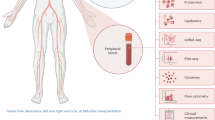Abstract
Alterations in DNA ploidy accompany hepatocellular carcinoma (HCC). However, changes in DNA content are also seen in regenerating liver and with increasing age. Thus, to investigate the role of DNA ploidy changes in development of HCC, flow cytometric DNA content determinations were done in a rat model system of peroxisome proliferator-induced HCC. Paraffin blocks of liver isolated from 18 Fisher 344 male rats fed ciprofibrate for 20 weeks (4), 40 weeks (4) or 20 months (10) were examined. Livers from age-matched control rats were also examined. From the 20 month ciprofibrate group, nine neoplastic nodules (NNs), 27 HCCs and four non-tumorous surrounding tissue controls (NTCs) were examined. Significant DNA tetraploid populations were seen in both the NNs and NTCs. A significant increase in the percentage of DNA diploid cells was observed in the NN samples. No significant difference in the percentage S-phase cells was seen. Emergence of cell populations with new DNA ploidy classes (8c or DNA aneuploid) as compared with NTCs was only seen in HCCs (7 of 27), and five of these seven were DNA aneuploid, as distinct from DNA tetraploid, populations. A total of 16 of 24 HCC samples that were adequate for cell cycle analysis had average percent S-phase greater than the mean of the NTCs plus three standard deviations. Although a direct role cannot be inferred, these results support the hypothesis that increases in the fraction of diploid cells is an important early event in the development of rat HCC and that further alterations in DNA ploidy and increased proliferative fraction accompany the development of HCC.
This is a preview of subscription content, access via your institution
Access options
Subscribe to this journal
Receive 24 print issues and online access
$259.00 per year
only $10.79 per issue
Buy this article
- Purchase on Springer Link
- Instant access to full article PDF
Prices may be subject to local taxes which are calculated during checkout
Similar content being viewed by others
Author information
Authors and Affiliations
Rights and permissions
About this article
Cite this article
Goolsby, C., Rao, M. Flow cytometric analysis of neoplastic nodules and hepatocellular carcinomas induced by ciprofibrate in the rat. Br J Cancer 73, 197–202 (1996). https://doi.org/10.1038/bjc.1996.35
Issue Date:
DOI: https://doi.org/10.1038/bjc.1996.35



